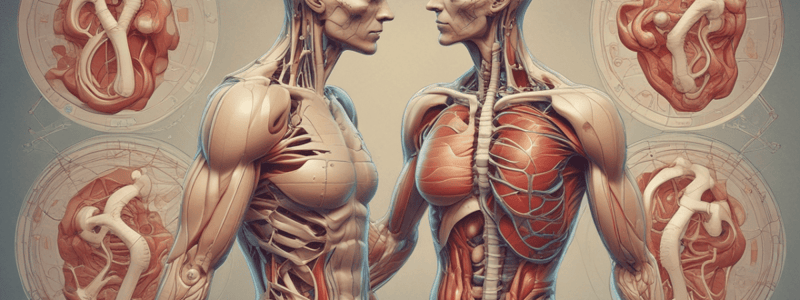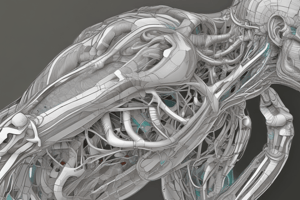Podcast
Questions and Answers
What is the primary muscle involved in hip adduction?
What is the primary muscle involved in hip adduction?
- Piriformis
- Adductor Magnus (correct)
- Gluteus Medius
- Iliacus
What is the degree of hip extension?
What is the degree of hip extension?
- 90 degrees
- 20 degrees (correct)
- 120 degrees
- 45 degrees
Which muscle is involved in seated internal rotation of the hip?
Which muscle is involved in seated internal rotation of the hip?
- Gluteus Medius
- TFL (Tensor Fascia Lata) (correct)
- Iliacus
- Gluteus Maximus
Which movement has a soft end feel with a degree value of 120?
Which movement has a soft end feel with a degree value of 120?
Which muscle assists in hip extension?
Which muscle assists in hip extension?
Which joint movement has a degree of 50?
Which joint movement has a degree of 50?
Which movement corresponds to a soft end feel?
Which movement corresponds to a soft end feel?
How many degrees is the ankle inversion at the subtalar joint?
How many degrees is the ankle inversion at the subtalar joint?
What is the degree of knee flexion?
What is the degree of knee flexion?
Which of the following movements has the same degree of motion?
Which of the following movements has the same degree of motion?
Flashcards are hidden until you start studying
Study Notes
Knee Degrees of Motion
- Knee flexion occurs up to 135 degrees, facilitated by the hamstrings, with a soft end feel.
- Knee extension occurs up to 0 degrees, facilitated by the quadriceps, with a firm end feel.
Ankle Degrees of Motion
- Ankle dorsiflexion occurs up to 20 degrees.
- Ankle plantarflexion occurs up to 50 degrees.
- Tarsal joint inversion occurs up to 35 degrees.
- Subtalar joint inversion occurs up to 5 degrees.
- Tarsal joint eversion occurs up to 20 degrees.
- Subtalar joint eversion occurs up to 5 degrees.
Hip Degrees of Motion
- Hip flexion occurs up to 120 degrees, facilitated by the iliopsoas muscle (iliacus), with a soft end feel.
- Hip extension occurs up to 20 degrees, facilitated by the gluteus maximus.
- Hip abduction occurs up to 45 degrees, facilitated by the gluteus medius.
- Hip adduction occurs up to 20 degrees, facilitated by the adductor magnus.
- Seated internal rotation occurs up to 45 degrees, facilitated by the tensor fasciae latae (TFL).
- Prone internal rotation occurs up to 45 degrees.
- Seated external rotation occurs up to 45 degrees, facilitated by the piriformis.
- Prone external rotation occurs up to 45 degrees.
Studying That Suits You
Use AI to generate personalized quizzes and flashcards to suit your learning preferences.




